17 Yellow Birds in Michigan – Explore Their Characteristics
Updated: 11 Mar 2024
76
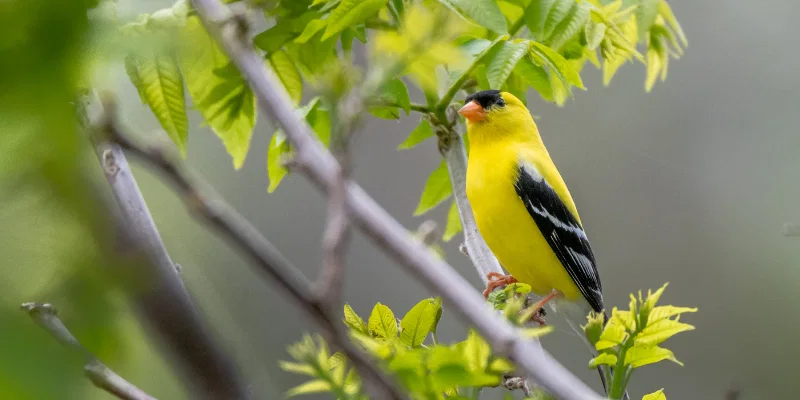
Michigan’s diverse landscapes offer a haven for birdwatchers and nature enthusiasts alike. Among the many species that call this state home, the sight of yellow birds soaring through the skies adds a vibrant touch to the natural tapestry. Join us as we uncover the beauty of Michigan’s golden-winged treasures!
In this guide, we’ll explore the charm of 17 yellow bird species found in Michigan. With easy-to-follow descriptions and helpful pictures, you’ll soon become familiar with these bright avian residents, adding a splash of color to your outdoor adventures.
Here’s a list of 17 yellow birds found in Michigan:
1. American Goldfinch:
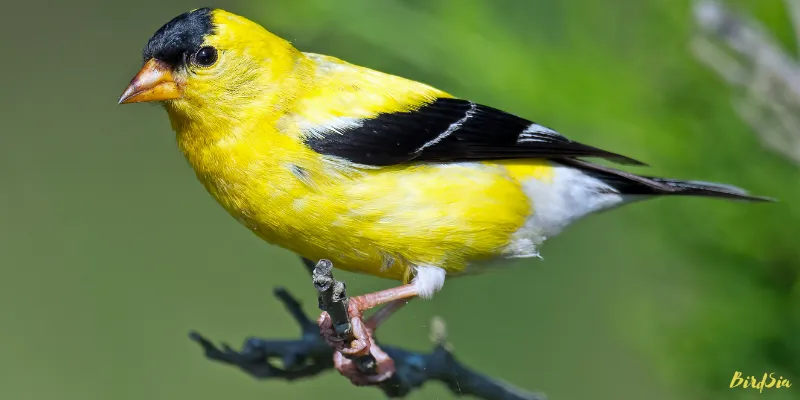
During the breeding season, male American goldfinches are easy to spot with their bright yellow feathers, black foreheads, and wings. Females and non-breeding males are lighter yellow and don’t have the black cap. In winter, males lose their bright colors and become duller.
American goldfinches stay in Michigan all year and can be found all over the state. They usually start breeding later than other birds, from June to August.
Measurement of the American Goldfinch (Spinus tristis):
- Length: 4.3-5.1 inches (11-13 cm)
- Weight: 0.4-0.7 ounces (11-20 g)
- Wingspan: 7.5-8.7 inches (19-22 cm)
To bring these yellow birds to your backyard, try using bird feeders made of goldfinches. They’re often scared away by bigger birds, so having their own feeding area helps. American Goldfinches are strict vegetarians, eating only seeds from garden plants and bird feeders.
2. Wilson Warbler:
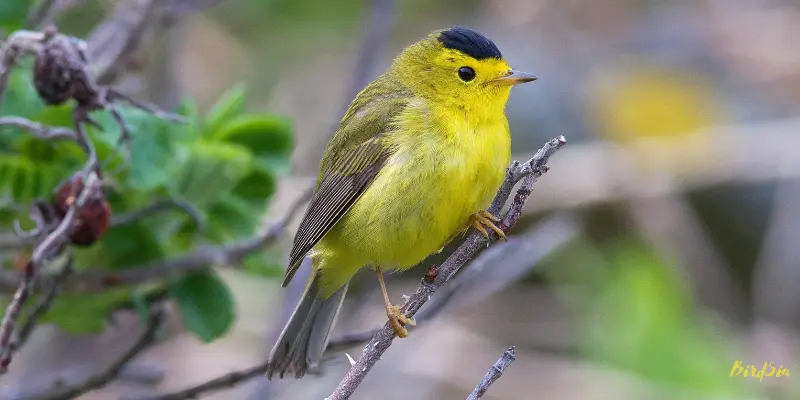
The Wilson’s warbler is a beautiful bird with mostly yellow feathers, along with an olive-colored back and wings that are grayish-green to olive. Both males and females look similar, but males have black caps on their heads.
Measurement of Wilson Warbler (Cardellina pusilla)
- Length: 3.9–4.7 inches (10–12 cm)
- Weight: 0.2–0.3 ounces (5–105.5–6.7 g)
- Wingspan: 5.5–6.7 inches (14–17 cm)
Unlike other warbler species that stay high in the trees, Wilson’s warblers often search for food on the ground and in low bushes. This behavior makes them easier to spot without straining your neck! They often build their nests on the ground, concealed within shrubs at the edges of forests.
They fly south for winter and breed in the north, but you can see them in Michigan during their spring and fall travels. Look for them around May and September.
3. Yellow Warbler:
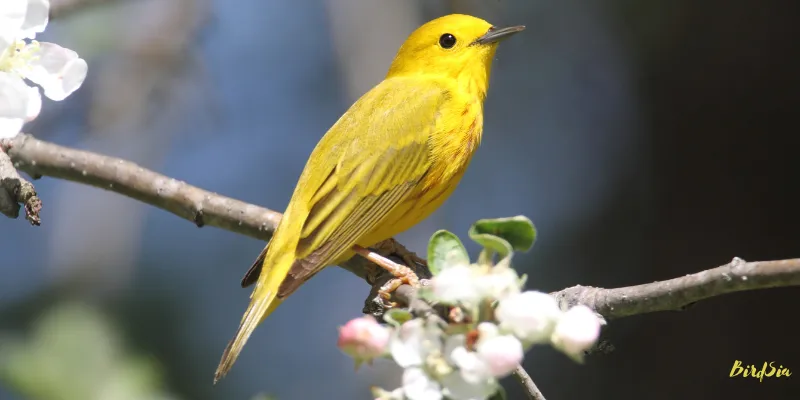
The yellow warbler is a small songbird. These small, bright yellow birds have a yellow-green back, with males distinguished by chestnut streaks on the breast. Females and juveniles display less vibrant colors compared to males.
Yellow Warblers, scientifically known as Setophaga petechia, migrate long distances to breed in Canada and the US (except for southeastern states) before heading back to Central and South America for winter. However, they can also be observed during migration in southeastern US states.
You’ll often find Yellow Warblers along streams, wetlands, and the edges of fields, foraging for insects like caterpillars, midges, beetles, bugs, and wasps.
Measurement of Yellow Warbler (Setophaga petechia):
- Length: 4.7–5.1 inches (12–13 cm)
- Weight: 0.3–0.4 ounces (9–11 g)
- Wingspan: 6.3–7.9 inches (16–20 cm)
Yellow Warblers nest in small trees or shrubs, crafting their homes with bark, grass, and plant materials secured with spider webs. The interiors are lined with softer materials like feathers and plant fluff.
Females lay up to seven eggs, which hatch after about twelve days. The young birds leave the nest approximately ten days later.
To attract Yellow Warblers to your backyard, consider offering suet, oranges, peanut butter, and plants with berries. Planting native plants that attract insects without pesticides is also helpful. Providing birdbaths with fountains near secluded planting areas can offer protection.
4. Common Yellowthroat:
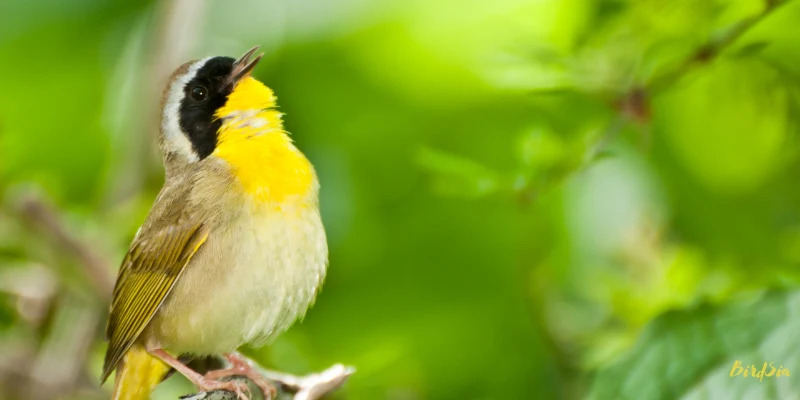
The common yellowthroat is a warbler found across much of the U.S. during the breeding season, and it’s one of the most common warblers. These little songbirds boast brownish backs paired with vibrant yellow undersides, topped off with long tails.
Adult males have a black mask across their faces and a bright yellow throat and breast. They also have olive-green upperparts and a yellow belly.
Females look similar but lack black masks, and their overall coloring is more muted. In Michigan, common yellowthroats are summer residents and can be found throughout the state.
Measurement of Common Yellowthroat (Geothlypis trichas):
- Length: 4.3-5.1 inches (11-13 cm)
- Weight: 0.3–0.3 ounces (9–10 g)
- Wingspan: 5.9–7.5 inches (15–19 cm)
To attract Common Yellowthroats to your backyard, create dense vegetation and plant native species that attract insects.
Common Yellowthroats build their nests near the ground in marshy areas, often supported by reeds and made from grass and sedges. They lay up to six eggs, which hatch after about twelve days, and the young leave the nest after the same amount of time.
5. Eastern Meadowlark:

The Eastern Meadowlark is a medium-sized songbird with a sturdy build. Their back and wings are mainly brown, with black and white streaks. However, their most eye-catching feature is the bright yellow coloring on their throats and bellies and a distinct V-shaped black patch on their chests.
Eastern Meadowlarks are present year-round across eastern US states and breed in the Northeast and Canada before migrating south.
Measurements of Eastern Meadowlarks (Sturnella magna):
- Length: 7.5–10.2 inches (19–26 cm)
- Weight: 3.2–5.3 ounces (90–150 g)
- Wingspan: 13.8–15.8 inches (35–40 cm)
Their arrival and singing mark the arrival of spring in the East. They can be found on the ground in grasslands and prairies, feeding on insects. During the winter, they gather in large flocks in fields, searching for seeds.
6. Prothonotary Warbler:
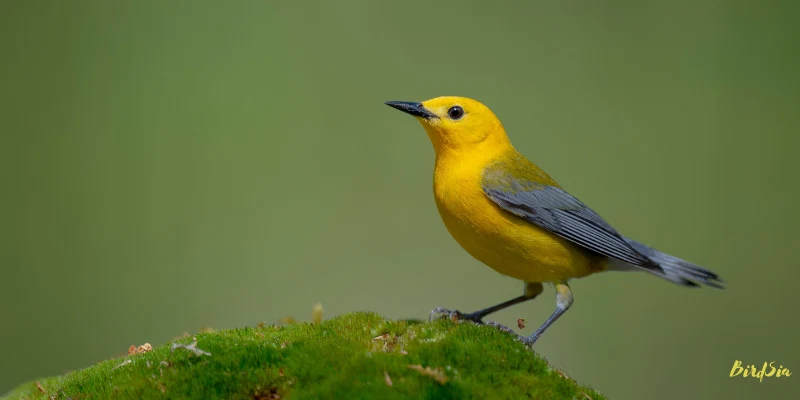
Prothonotary Warblers are bright yellow with blue-gray wings and tails. They are larger than typical warblers and have thick black beaks with white undersides of their tails. Females are typically less brightly colored than males.
Prothonotary Warblers breed in eastern US states and migrate to Mexico and northern South America for the winter.
You can spot Prothonotary Warblers near streams and wet woodlands, where they forage for spiders, insects, and snails. In winter, they also consume fruit and seeds.
Measurement of Prothonotary Warbler (Protonotaria citrea):
- Length: 5.1 inches (13 cm)
- Weight: 0.44 ounces (12.5 g)
- Wingspan: 8.75 inches (22 cm)
Their nests are built in abandoned woodpecker nest holes near the water. Males line the hole with moss, and females construct cup-shaped nests from grass, leaves, and other plant materials.
They lay up to seven eggs, which hatch after about two weeks, with the young leaving the nest around ten days later.
To bring Prothonotary Warblers to your backyard, consider installing a nest box, especially if you live near wet areas. These birds prefer nesting in wooded wetlands, so providing suitable habitat can attract them to your yard.
7. Yellow-Throated Vireo:
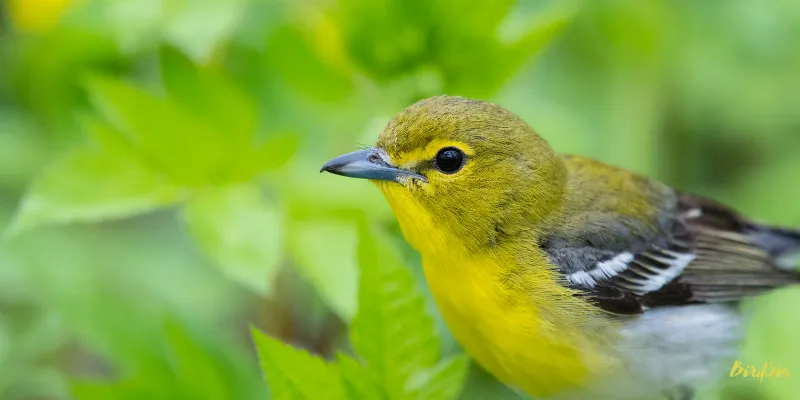
The yellow-throated Vireo is a medium-sized songbird, measuring 5.1–5.9 inches. These birds sport olive-green plumage on their heads that transitions into bright yellow feathers on their throats and chests. Notably, they have yellow rings around each eye, resembling yellow glasses.
Yellow-throated Vireos breed in eastern US states and migrate to Central and South America and the Caribbean for winter. You can find them in mixed woodlands, where they hunt for insects and occasionally feed on berries.
Measurement of Yellow-Throated Vireos (Vireo flavifrons):
- Length: 5.1–5.9 inches (13–15 cm)
- Weight: 0.5–0.7 ounces (15–21 g)
- Wingspan: 9.1 inches (23 cm)
Their nests are hanging cups built high up in trees, attached to a fork in a tree. They are made from bark, grass, pine needles, and other plant materials, held together and attached with spider webs and insect silk.
They typically lay around four eggs, which hatch after about two weeks, and the young birds leave the nest around two weeks later.
8. Northern Parula:
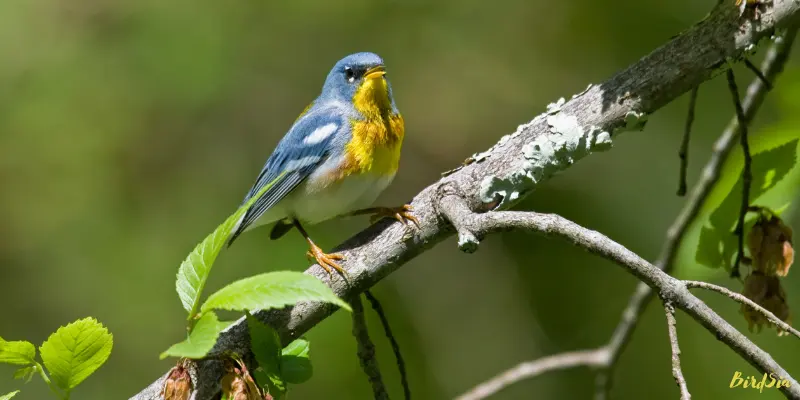
The Northern Parula is a small warbler with a short tail and a sharp beak. This species displays a blue-gray head, wings, and tail, along with bright yellow plumage on the throat, chest, and back. They also feature a white belly and white spots above and below each eye. Males typically have deeper coloring and a rusty spot on their chest.
Measurement of Northern Parula (Setophaga americana):
- Length: 4.3-4.7 inches (11-12 cm)
- Weight: 0.21-0.38 ounces (6-11 grams)
Northern Parulas are migratory birds, wintering in the Caribbean and Mexico. During the summer breeding season, they inhabit northern hardwood and mixed forests in far northern Michigan. The rest of the state can spot them during their spring and fall migrations.
9. Yellow-Breasted Chat:

The Yellow-breasted Chat breeds across various regions of the U.S., including lower Michigan, but winters in Central America. It boasts a long tail and bulky body, with a bright yellow breast and throat. Its head and back are gray, and it sports a distinctive black and white stripe around each eye.
Measurement of Yellow-Breasted Chat (Icteria virens):
- Length: Approximately 7.5 inches (19 cm)
- Weight: About 0.8-1.3 ounces (23-37 grams)
- Wingspan: 7.9–9.1 inches (20 to 23 cm)
Yellow-breasted Chats prefers dense vegetation, such as thickets and brambles. They are most active and vocal during the spring months, as they tend to be silent and shy during the rest of the year.
10. Summer Tanager:
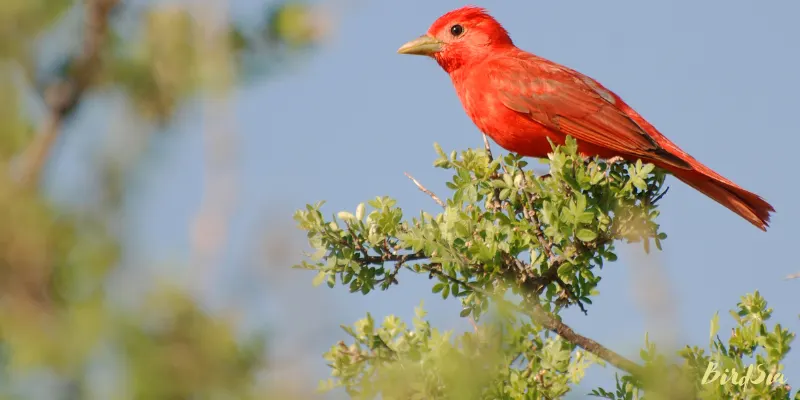
Summer Tanagers are not included in Michigan’s breeding range, but sightings have been reported between March and May as spring migrants return. These sightings are primarily in the southern portion of the state.
Measurement of Summer Tanager (Piranga rubra):
- Length: Approximately 6.3 to 7.5 inches (16 to 19 cm)
- Wingspan: Typically ranges from 10.6 to 11.8 inches (27 to 30 cm)
- Weight: About 0.8 to 1.3 ounces (23 to 37 grams)
Male Summer Tanagers are predominantly red, while females are entirely yellow. These birds primarily forage for insects in the treetops and are known for their ability to consume bees and wasps.
11. Scarlet Tanager:
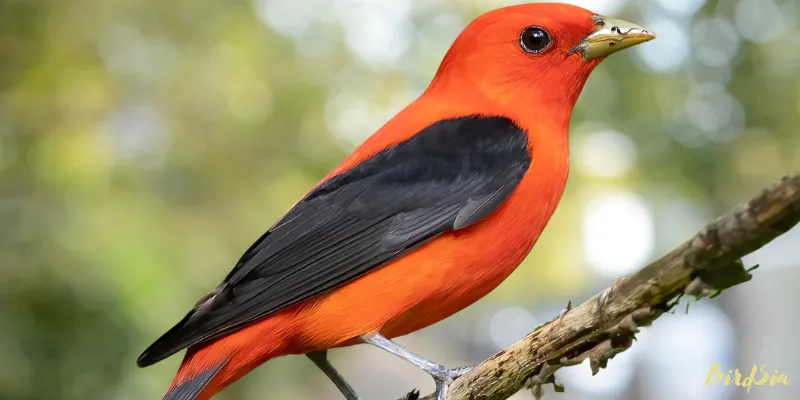
During the breeding season, male Scarlet Tanagers sport red plumage, while females are yellow. You can distinguish them by their wings, which are black on males and dark or dusky on females. During the non-breeding season, males molt to resemble females.
Measurement of Scarlet Tanager (Piranga olivacea):
- Length: Approximately 6.3 to 7.1 inches (16 to 18 cm)
- Wingspan: Typically ranges from 9.8 to 11.0 inches (25 to 28 cm)
- Weight: About 0.9 to 1.4 ounces (25 to 40 grams)
Scarlet Tanagers can be spotted during the spring and summer in the eastern United States, including Michigan. While their primary food source is insects, they may be attracted to yards with berry bushes.
12. Pine Warbler:

Pine Warblers breed in northeastern U.S. states before migrating to southeastern states. Some individuals of the species remain in the southeastern U.S. year-round. These small, plump yellow birds feature olive backs, white lower bellies, and gray wing bars. Females may appear browner and have more white on their bellies compared to males.
Pine Warblers live in pine forests and mainly eat insects like caterpillars, beetles, and spiders. When it’s cold, they also eat fruit and seeds. They build their nests in pine trees using twigs, bark, and grass held together with spider silk. They lay up to five eggs, which hatch in about two weeks. The babies leave the nest around ten days later.
Measurement of the Pine Warbler (Setophaga pinus):
- Length: 5.1–5.5 inches (13–14 cm)
- Weight: 0.3–0.5 ounces (9–15 g)
- Wingspan: 7.5–9.1 inches (19–23 cm)
To bring Pine Warblers to your yard, try using tube feeders and platform feeders filled with a mix of millet, cracked corn, sunflower seeds, peanut hearts, and suet. Also, consider planting native fruits and vines like bayberry, grape, sumac, and Virginia creeper, which can appeal to them.
13. Mourning Warbler:
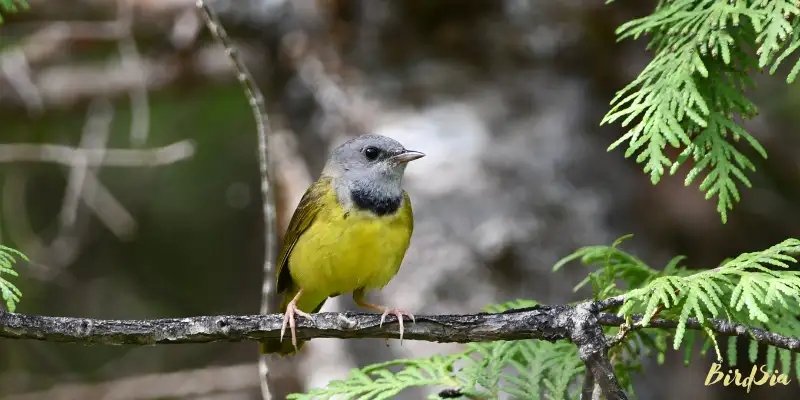
Mourning Warblers have a unique appearance with a striking combination of colors. They have a gray head, an olive-green back, and yellow underparts. The male has a black mask across his face, while the female has a lighter version. Both genders have a distinct white eye ring.
Mourning Warblers are neotropical migrants, breeding in North America during the summer and migrating to Central America and northern South America for the winter.
Measurement of the Mourning Warbler (Geothlypis Philadelphia):
- Length: Approximately 4.3 to 5.1 inches (11 to 13 cm)
- Weight: Around 0.3 to 0.4 ounces (8 to 11 grams)
- Wingspan: Approximately 6.7-7.5 inches (17 to 19 cm)
Mourning Warblers prefer dense undergrowth in deciduous or mixed forests, especially those with thick shrubs and vegetation near the ground. They can also be found in wetlands, forest edges, and second-growth forests. They primarily feed on insects and spiders but may also eat berries and fruits during migration.
14. Nashville Warbler:
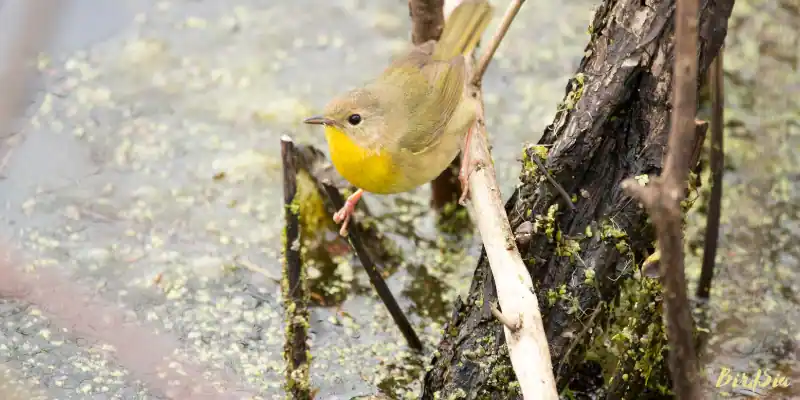
During the breeding season, Nashville Warblers inhabit northeastern US states and Canada, with some populations in the northwest US and British Columbia. They migrate to most US states during migration and spend winters mainly in Mexico.
These warblers have mostly yellow undersides with white lower bellies, greenish-yellow backs, and gray heads with white eyerings. Females and juveniles are less colorful compared to males.
Measurement of the Nashville Warbler (Leiothlypis ruficapilla):
- Length: 4.3-5.1 inches (11-13 cm)
- Weight: 0.2–0.5 ounces (6.7–13.9 g)
- Wingspan: 6.7–7.9 inches (17–20 cm)
Nashville Warblers construct their nests in shrubs near the ground, using bark, grass, and moss woven into a cup lined with softer material. They lay around four eggs, which hatch in about twelve days, and the young leave the nest around ten days later. In winter, you can attract Nashville Warblers to your backyard in southern US states with suet.
15. Evening Grosbeak:
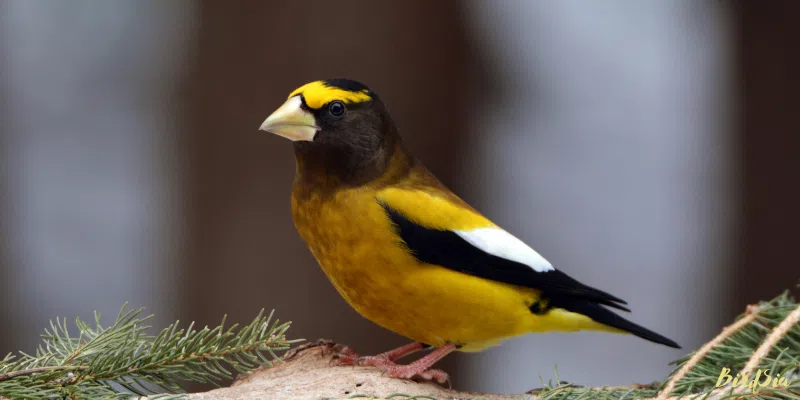
Evening Grosbeaks typically reside year-round in southern Canada and down the west coast to northern California. During poor cone crops, they migrate south to most US states.
These chunky birds have big bills and a striking yellow-and-black pattern. Adult males have a bright yellow stripe over their eyes, while females and juvenile males have greenish bills and mostly gray bodies with black and white wings.
Measurement of the Evening Grosbeak (Hesperiphona vespertina):
- Length: 6.3–8.7 inches (16–22 cm)
- Weight: 1.37–3.04 ounces (38.7–86.1 g)
- Wingspan: 12–14 inches (30–36 cm)
You can spot Evening Grosbeaks in forests and mountain regions, and they’re often attracted to bird feeders in backyards during winter, where they feed on sunflower seeds, berries, and maple buds.
Their nests, usually found up to 100 feet above ground in pine trees, are loosely made of twigs, rootlets, grass, moss, and pine needles. The female incubates up to five eggs for about two weeks until they hatch.
16. Cape May Warbler:

Cape May Warblers are primarily seen in Michigan during spring and fall migration, with a few staying for the breeding season in the northern part of the state.
Males of this species have distinctive heads with chestnut cheeks, dark caps, and a ring of yellow around the neck. Their upperparts are mottled yellow-olive, while their underparts are yellow with dark streaks.
The distinctive tiger stripes on their chests and unusually dark crowns make them easily recognizable. Females and immature Cape May Warblers are less vibrant and lack the bold head coloring of the males.
Measurement of Cape May Warbler (Setophaga tigrina):
- Length: 4.7–5.1 inches (12–13 cm)
- Weight: 0.4-0.5 ounces (10.2-15.2 g)
- Wingspan: 7.9–8.7 inches (20–22 cm)
Cape May Warblers breed in Canada, wintering in the Caribbean and Central America. During migration, they seek insects near woodland edges. In summer, they favor spruce forests, feeding on spruce budworms; in winter, they eat fruit and nectar.
Their nests, high in spruce trees, are made of twigs and lined with feathers. To attract them, plant insect-attracting shrubs and trees, and offer fruit and hummingbird feeders.
17. Blue-Winged Warbler:
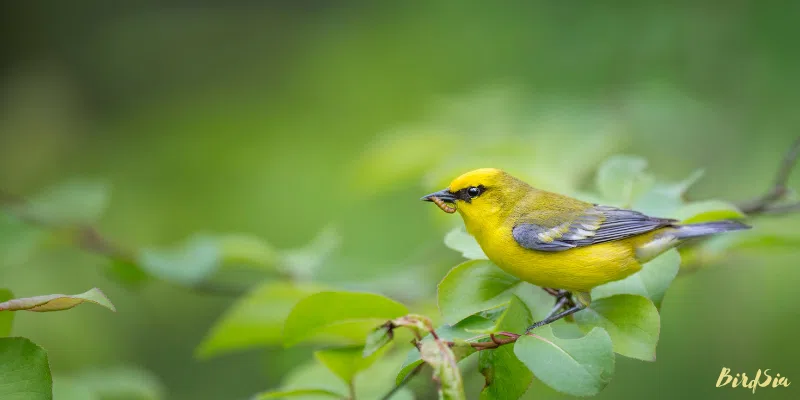
Blue-Winged Warbler sport yellow-green backs with black eye lines and bright yellow bellies. Females are slightly paler. Juveniles have thin, almost invisible white wing bars.
These warblers breed in eastern US states, migrating to Mexico, Central America, and the Caribbean for the winter. Look for them in abandoned fields, forest edges, and thickets, especially in higher-elevation areas with grass and canopy cover.
Measurement of the Blue-Winged Warbler (Vermivora cyanoptera):
- Length: 4.75 inches (12 cm)
- Weight: 0.3 oz (9 g)
- Wingspan: 6.75 – 7.5 inches (17 – 19 cm)
Feeding mainly on insects and spiders, they forage in various plants and trees, sometimes hanging upside down to find insect larvae. Their cup-shaped nests, made of dead leaves, are often found on the ground or in bushes. They may lay four to seven eggs, incubating them for about 12 days.
Blue-winged Warblers are known to hybridize with Golden-winged Warblers, producing Brewster’s and Lawrence’s Warblers.
Final Thought:
In conclusion, Michigan offers a diverse array of yellow birds that contribute to the state’s rich avian tapestry. From the vibrant American Goldfinch to the striking Blue-winged Warbler, each species brings its own unique charm and beauty to the landscape. Whether you’re a seasoned birdwatcher or a casual observer, exploring Michigan’s natural habitats provides ample opportunities to encounter these colorful residents.
By understanding the characteristics, habitats, and behaviors of these yellow birds, enthusiasts can enhance their birdwatching experiences and contribute to conservation efforts. From attracting them to backyard feeders to preserving their natural habitats, there are many ways to appreciate and protect these feathered wonders.
So, grab your binoculars, head outdoors, and immerse yourself in the enchanting world of Michigan’s yellow birds. Happy birding!
What is the most common yellow bird?
Goldfinches are commonly found across much of North America, except in dense forests. Their distinctive “po-ta-to-chip” flight call often attracts attention in open areas. They thrive in regions with thistle plants and are frequently seen near feeders.
What is the little bird with yellow on it?
Goldcrests, the UK’s smallest bird, have a distinctive crest of bright feathers on their heads. Females have a completely yellow crest, while males have an orange center.
How rare is the yellow bird?
When the elusive yellow cardinal makes an appearance, it tends to become a viral event, as experts estimate there are only 10–15 of these rare birds in North America.
What are the yellow birds about?
“In The Yellow Birds” by Kevin Powers, we follow the story of two young soldiers, Private John Bartle and Private Daniel Murphy, as they navigate the brutal terrain of the Iraq War. Murphy, a naive teenager, and Bartle, a slightly older and reluctant mentor, struggle to hold on to their humanity amidst the chaos and violence of war.
Please Write Your Comments